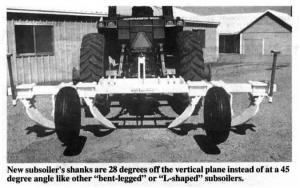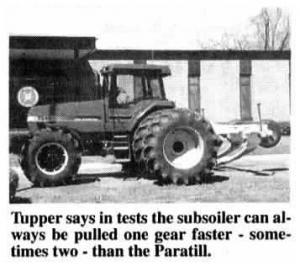Subsoiler Cuts Drag, Surface Disturbance
"It fractures the soil with minimum disturbance to the surface like other parabolic subsoilers, but soil doesn't clod up as it will with a regular parabolic shank thanks to the new design," says Mississippi ag engineer Gordon Tupper about his new parabolic subsoiler.
"This design reduces draft requirements by about 20 percent over that required by other subsoilers," adds Tupper, who de-signed the low-disturbance, low-drag till-age tool at Mississippi State University's Delta Research and Extension Center at Stoneville, Miss.
The key to success of Tupper's subsoiler, which is now being manufactured by five southeastern U.S. companies, is the changed angle at which the shanks run through the earth. They're 28 degrees off the vertical plane instead of at a 45 degree angle like other "bent legged" or "L-shaped" subsoilers such as the Paratill.
The upshot is that shanks run within the soil fracture line under all conditions, not just under ideal conditions as has been the case with the Paratill, Tupper says. As a result, it pulls much easier, he says.
For example, Tupper says in tests the subsoiler can always be pulled one gear faster - sometimes two - than the Paratill machine. "In one test, we covered 11.4 per-cent more acreage per day than the Paratill," he says.
The shank itself, which is made out of 1 1/4-in., T-1 steel, is about 6 in. longer than a conventional parabolic shank to permit better trash clearance and to make up for the depth lost by turning the shank at an angle.
Tupper's subsoiler,-which is available in 4 and 6-row units, is set up for 40-in. rows but can easily be adjusted to 38-in. rows. For narrower rows, a smaller foot and shank may be necessary, he says.
Contact: FARM SHOW Followup, Gordon Tupper, Agricultural Engineering, Delta Research and Extension Center, Mississippi State University, P.O. Box 197, Soneville, Miss. 38776 (ph 601-686-9311).

Click here to download page story appeared in.
Click here to read entire issue
Subsoiler Cuts Drag, Surface Disturbance SUBSOILERS Subsoilers (58n) 19-1-3 "It fractures the soil with minimum disturbance to the surface like other parabolic subsoilers, but soil doesn't clod up as it will with a regular parabolic shank thanks to the new design," says Mississippi ag engineer Gordon Tupper about his new parabolic subsoiler.
"This design reduces draft requirements by about 20 percent over that required by other subsoilers," adds Tupper, who de-signed the low-disturbance, low-drag till-age tool at Mississippi State University's Delta Research and Extension Center at Stoneville, Miss.
The key to success of Tupper's subsoiler, which is now being manufactured by five southeastern U.S. companies, is the changed angle at which the shanks run through the earth. They're 28 degrees off the vertical plane instead of at a 45 degree angle like other "bent legged" or "L-shaped" subsoilers such as the Paratill.
The upshot is that shanks run within the soil fracture line under all conditions, not just under ideal conditions as has been the case with the Paratill, Tupper says. As a result, it pulls much easier, he says.
For example, Tupper says in tests the subsoiler can always be pulled one gear faster - sometimes two - than the Paratill machine. "In one test, we covered 11.4 per-cent more acreage per day than the Paratill," he says.
The shank itself, which is made out of 1 1/4-in., T-1 steel, is about 6 in. longer than a conventional parabolic shank to permit better trash clearance and to make up for the depth lost by turning the shank at an angle.
Tupper's subsoiler,-which is available in 4 and 6-row units, is set up for 40-in. rows but can easily be adjusted to 38-in. rows. For narrower rows, a smaller foot and shank may be necessary, he says.
Contact: FARM SHOW Followup, Gordon Tupper, Agricultural Engineering, Delta Research and Extension Center, Mississippi State University, P.O. Box 197, Soneville, Miss. 38776 (ph 601-686-9311).
To read the rest of this story, download this issue below or click
here to register with your account number.








